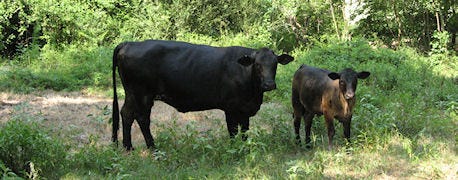October 1, 2014

By Robert and Janelle Fears
Developing and executing a good animal nutrition plan is important for herd profitability because supplementation is one of the top expenses.
Writing the plan down is the key to executing it.
There are at least three good reasons to do so.
1. Write it down to show your loan officer.
2. If your plan is written it is easier to show how nutrition expenses affect the overall profit/loss statement.
3. It's hard to carry animal weights and forage inventories in your head, particularly when figures can change during the year.
In the process of writing down such a plan, you should answer five questions say Rick Machen and Ted McCollum, Texas A&M AgriLife animal nutritionists.

Needs for feed: The amount of feed required by a cow depends upon where she is in her reproduction cycle. You also need to know the average weight of your cattle in order to determine their nutrient requirements.
1. How much do your cattle eat? You must know the average weight of your cow herd in order to write a meaningful nutrition plan. Weigh each of your animals individually. Don't try to estimate animal weight without checking your estimates with a scale. Very few beef producers can estimate cattle weights accurately. Yet body weight is the largest factor affecting pounds of required nutrients. See Table 1.
2. What stage of production are the cows in? You can feed much more efficiently and economically with a controlled breeding season. Alternately, if cows calve all year long, the herd needs to be fed based on the nutrient requirements of cattle in early lactation. This results in over-feeding the herd as a whole.
In order of increasing nutrient demand, the four stages of production are:
Mid-gestation –> late gestation –> late lactation –> early lactation.
Yet the order in which the production stages occur is:
Mid-gestation –> late gestation –> early lactation –> late lactation.
Depending on calf age at weaning, late lactation and mid-gestation may overlap.


You can use Table 1 and Table 2 to compare nutrient requirements between two production stages for a given cow weight. You'll see the requirements for every nutrient listed are higher for a cow in the first three to four months of lactation than for a female in the middle one-third of gestation.
If the entire herd is in the same reproduction stage at the same time, feed requirements can be mapped by month in your nutrition plan.
~~~PAGE_BREAK_HERE~~~
3. What production responses do you expect? List production goals in your nutrition plan because they help determine how the herd should be fed. Reproductive performance is closely related to nutrition. Research has clearly demonstrated cows need to be in body condition of 5 or better to facilitate early lactation and a timely return to estrus.
To maintain a calving interval of 365 days or less, a cow must conceive within 90 days after calving. Cows in a body condition score of 5 to 6 at calving can utilize body reserves and lose weight while sustaining lactation and reproduction. Weight gain results when nutrient intake exceeds nutrient demand; hence the most efficient conversion of supplement to body weight gain is expected to occur after weaning and prior to late gestation.
4. What and how much forage must your cattle eat? Understanding the quantity and quality of the forage being consumed is fundamental to designing a nutrition plan for beef cows. If a cow is roaming over several acres of native range, consuming a mixture of grasses, forbs and maybe some browse, estimating diet quality is difficult. Observing grazing behavior and the consistency of feces are useful indicators of forage availability and quality, respectively.
5. What supplements are available? Gather information on the amount and type of supplemental nutrients available to you. This situation analysis prepares you to choose the type of nutrients needed for your desired animal performance.
Once you have identified the first production-limiting nutrient, evaluate your available supplements on a cost-per-unit basis. Most supplements contain both protein and energy, so it becomes a balancing challenge to determine which supplement can best meet nutrient needs at the most economical cost, not necessarily the lowest cost.
Oklahoma State University has developed Cowculator, a free software program to help answer these last questions and then develop the supplementation portion of your nutrition plan. Cowculator may be downloaded at no cost.
~~~PAGE_BREAK_HERE~~~
Texas rancher does it
Murray Randle says he finds a good nutrition plan is essential for profitable beef cattle production.
"I raise my own hay and have it tested for nutrient content after every cutting," says Randle, who ranches near Granbury, Texas. "The analysis is used to determine if I need to feed a protein supplement and if so, how much.
"Another important part of the hay tests is the mineral content analysis. This information tells me the type of mineral mix I should have available for my cattle."
Randle says he routinely checks cow pats for shape and consistency.
"If they aren't flat, I immediately make adjustments to my feeding program," he adds. "I monitor body condition of my animals as a second check on whether the right nutrition program is in place. The problem of using animal body condition as the only gauge is that once an animal decreases in body condition score, it takes a lot of feed to regain it. This is especially true if the animal is lactating."
Randle's attention to nutrition is clearly evident in his herd's production. His calving percentage is over 90% and he weans 550-pound calves. Randle breeds longevity into his herd and expects his heifers to have their first calves prior to reaching two years of age. He normally gets the last calf from his cows at the age of 12.
The Fearses write from Georgetown, Texas.
You May Also Like




